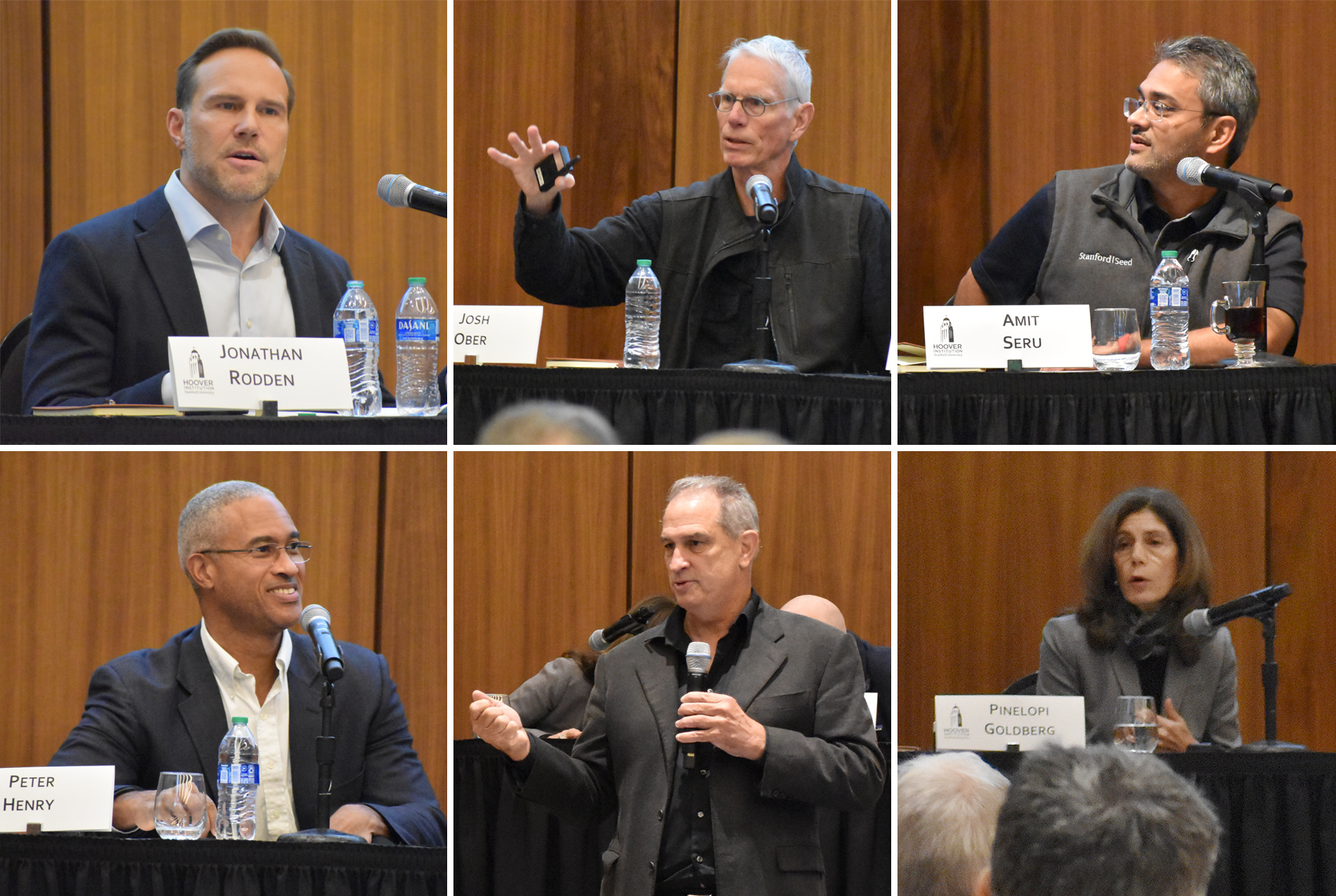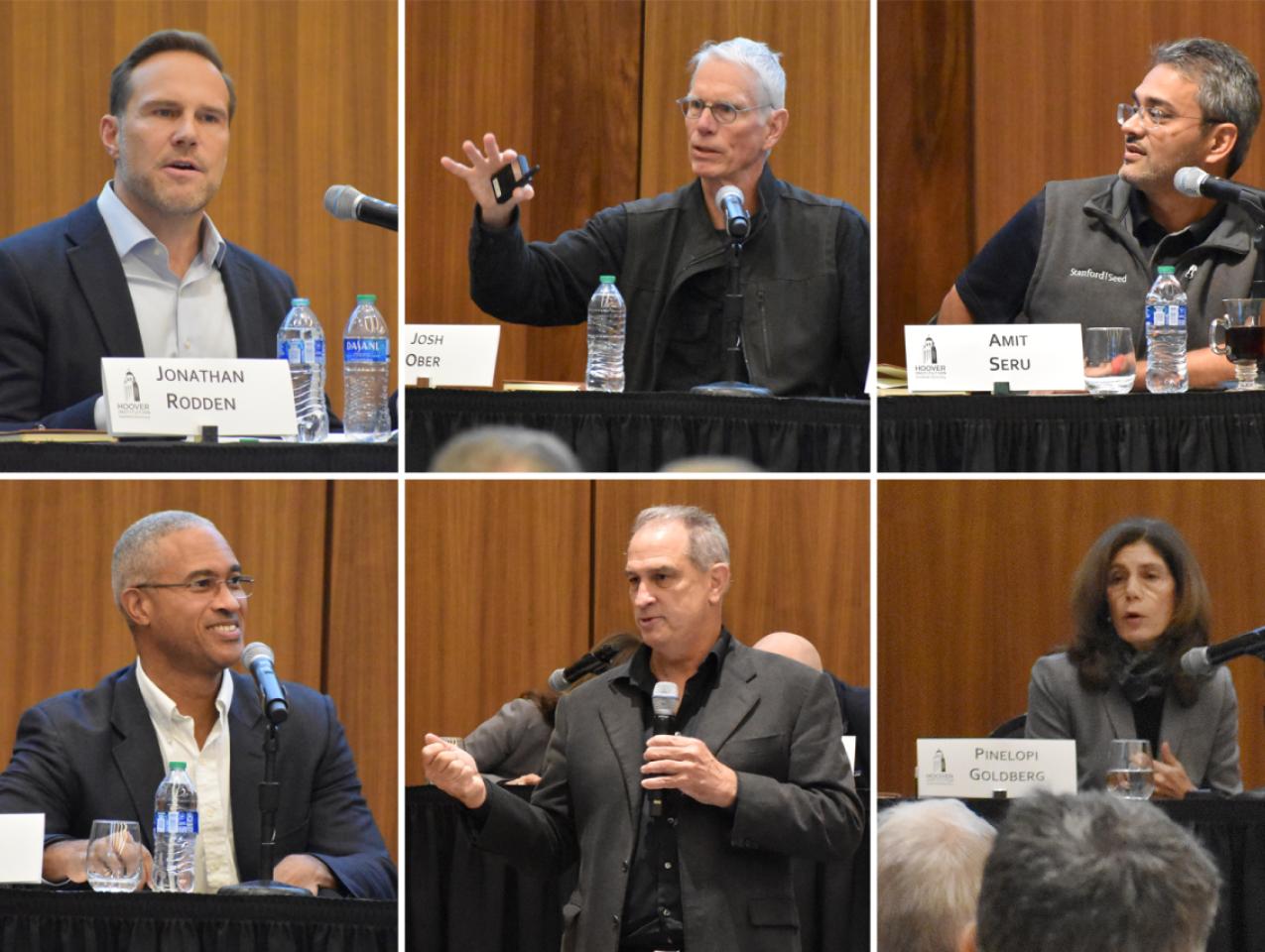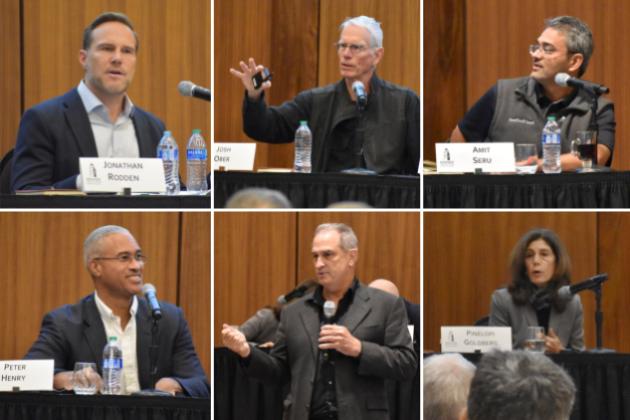By Natalia Vasilenok and Isabel Lopez Ysmael
Once a prosperous town, Selma, Alabama, is today one of the state’s poorest cities. In a welcome address to the participants of the Sustaining Economic Growth conference of the Working Group on the Foundations of Long-Run Prosperity on November 17–18, Stephen Haber, senior fellow at the Hoover Institution and cochair of the working group, posed a question related to Selma’s reversal in economic prosperity: What are the origins of economic growth and stagnation, and what accounts for their reversals?
The six sessions of the conference highlighted both obstacles to economic growth—such as the gender gap in the labor market and poor infrastructure in developing countries—and episodes of prolonged economic growth that predated the Industrial Revolution. Cochairs Stephen Haber and Hoover Institution senior fellow Amit Seru explained that gaining a deeper understanding of the barriers to continued growth can help us explain why episodes of preindustrial growth ended and provide policy makers with insights to help sustain contemporary economic growth.
Barriers to Female Entrepreneurship
Pinelopi Goldberg of Yale University opened the conference with her paper “Aggregate Implications of Barriers to Female Entrepreneurship,” which she coauthored with Gaurav Chiplunkar. The paper studies the underrepresentation of women in the labor market with a focus on the case of India. Demonstrating that female entrepreneurs in India tend to hire more women, Goldberg and Chiplunkar suggest considering female entrepreneurship as one of the possible remedies for gendered labor market distortions. They argue that promoting female entrepreneurship will increase both the demand and the supply of the labor force without imposing a negative effect on wages. It may also contribute to overall productivity by introducing competition to male-owned businesses.
Discussion of the paper sought to unbundle the mechanisms behind the gender gap in the labor force market. Erik Hurst of the University of Chicago introduced the distinction between preferences, skills, and discrimination as the sources of lower labor force participation among women. Latika Chaudhary of the Naval Postgraduate School suggested that there might be substantial differences between India and the rest of the developing world.
- Presenter Slides: Pinelopi Goldberg
- Discussant Slides: Erik Hurst
- Discussant Slide: Latika Chaudhary
- Working Paper
- Research Briefing
Growth from Innovation: New Ideas Versus Incremental Improvements
Adopting and adapting foreign technology is an important source of catch-up growth in developing countries. But what are the relative contributions of invention (Romerian growth) versus improvements on existing technology (Ricardian growth) to productivity differences across the globe? Peter Klenow of Stanford University presented joint work with Chang-Tai Hsieh and Kazuatsu Shimizu, “Romer or Ricardo?,” which employs global trade data to distinguish Romerian growth from Ricardian growth. The authors suggest that an emergence of a new export category is suggestive of Romerian invention, while Ricardian improvement on foreign technology shows up as a simultaneous decrease in imports and an increase in exports. Following this approach, the authors estimate that around 57 percent of the world growth stems from improvement on existing technology. This share substantially varies across countries from 85 percent in China to 36 percent in the United States.
In the discussion, Andrew Atkeson of UCLA encouraged the authors to look at within-country distributions of innovation and assess if the distributions are optimal. Avi Acharya of the Hoover Institution and Stanford University pointed out that innovation and trade are shaped by the policies countries adopt, which means that studying trade might require incorporating politics into our theoretical models.
The Global Infrastructure Gap
In the paper “The Global Infrastructure Gap: Potential, Perils, and a Framework for Distinction,” Peter Henry of the Hoover Institution and Stanford University and coauthor Camille Gardner evaluate a World Bank initiative inviting private capital to invest in infrastructure in developing countries. The authors introduce a novel dual-hurdle framework that can help to assess an investment decision in terms of its efficiency and profitability. Their model considers an investment tenable when the social rate of return on infrastructure (i.e., the amount of GDP generated by an additional dollar of investment in infrastructure) in a poor country exceeds both the social rates of return on private capital in that country as well as rates of return on investment in private capital in a rich country. Using data published by the World Bank in 1985—the only available data on economic returns on paved roads and electricity—Henry and Gardner find that only 7 of 53 countries clear the dual-hurdle framework for investment in infrastructure. The authors stressed the importance of updating the World Bank data because in its absence, institutional investors are less likely to invest in developing nations’ infrastructure, resulting in missed opportunities for rich and poor countries.
During the discussion, William Summerhill of UCLA pointed out that it is important to understand what has gone awry in the countries clearing the dual-hurdle framework. Why has investment not occurred in such places despite the potential for economic gains? Valerie Ramey of UC San Diego pointed out that since the 1980s—when the World Bank data in question was published—the legal barriers to foreign loans have been substantially eased, approaching perfect capital markets. In theory, global rates of return on private capital should equalize under such conditions, which would render the modeling of social rates of return on private capital in poor countries less important.
Economic Development in Antiquity
Josh Ober of the Hoover Institution and Stanford University offered an institutional account of the ancient Greek economic “miracle” in his paper “Economic Development in Antiquity: The Greek World, 800–300 bce.” Spanning a period of five hundred years—and, according to some data, at its peak reaching the levels of Golden Age in Holland—Greek economic growth was supported by institutions shaped by collective rule that constrained executive authority, protected property rights, and allowed taxation based on income and wealth. City-states emulated political and economic institutions of other successful city-states. Relying on the classical work of the Greek philosophers, Ober argues that an expectation of other economic agents acting rationally prevailed in ancient Greek society, which reduced transaction costs and promoted cooperation between city-states.
In the discussion, Jonathan Rodden of Hoover Institution and Stanford University pointed out that the bulk of growth happened prior to democratic reforms in ancient Greece, questioning if the Greek economic growth was caused by institutions or, rather, followed them. Ross Levine of UC Berkeley contrasted the industrial growth rate with the ancient world, which developed at a very low rate, implying that economic changes might not have been evident within a generation.
- Presenter Slides: Josh Ober
- Discussant Slides: Jonathan Rodden
- Discussant Slides: Ross Levine
- Working Paper
- Research Briefing
When Did Economic Growth Begin?
Jón Steinsson opened the second day of the conference with the paper “When Did Growth Begin? New Estimates of Productivity Growth in England from 1250 to 1870,” coauthored with Paul Bouscasse and Emi Nakamura. The authors construct a six-century-long productivity data series for England and use it to model a preindustrial Malthusian economy, in which a productivity increase induces population growth, leading to falling wages. Using data on real wages and labor supply, the authors estimate productivity as shifts in the labor demand curve. In their analysis, the authors date the start of productivity growth back to 1600, leading them to question the institutional explanation of productivity growth because its start predates the political reforms of the seventeenth century in England. They suggest that rapid growth after 1760 was perhaps due in large part to a decrease in the importance of land as a factor of productivity as new technologies were developed.
Jim Robinson of the University of Chicago suggested that the new estimates might not be inconsistent with the institutional perspective. Even before the Glorious Revolution, there was considerable coevolution of economic and political institutions in England. Jean-Laurent Rosenthal of Caltech stressed the importance of incorporating the distribution of income across the population into the paper. Despite the onset of productivity growth, not enough food was produced and distributed among the lower quartile of the population, impacting the physical and biological capital of subsets of the population.
- Presenter Slides: Jón Steinsson
- Discussant Slides: Jim Robinson
- Discussant Slides: Jean-Laurent Rosenthal
- Working Paper
- Research Briefing
Prosperity in the Very Long Run
Concluding the conference, Ian Morris of Stanford University put forward a novel perspective on prosperity in his presentation of the paper “Prosperity in the Very Long Run.” Defining prosperity as the accumulation of energy flows over human history, Morris argues that social scientists should consider this alternate, yet significant, viewpoint based on work in the natural sciences. Employing kilocalories per person per day as a measure of prosperity, the paper demonstrates that human prosperity has been steadily growing—with some periods of stagnation and reversal—for at least 45,000 years. On top of consuming more energy, humans have also been increasing the efficiency with which they use it and the range of ends to which they have been applying it. While economic growth over human history has been paltry by modern standards, this result does push back against the widespread accounts of an absence of growth prior to the Neolithic Revolution.
The discussion revolved around varying perspectives on understanding long-run development. Chad Jones of Stanford University stressed the importance of incorporating ideas as the source of growth into our theories of preindustrial development, on top of labor and land. While population growth drives wages down, it also engenders the emergence of new ideas which, holding population constant, drive the wages up. Deborah Gordon of Stanford University provided an evolutionary biologist’s perspective on long-run growth. Gordon, drawing from her research on ant colonies, pointed out that evolutionary success does not always require reliance on optimal and efficient behavior. She pushed back against Morris’s argument that the fact humans were using increased amounts of energy (i.e., becoming more prosperous) over generations implied that humans were capturing or utilizing energy more efficiently.
























